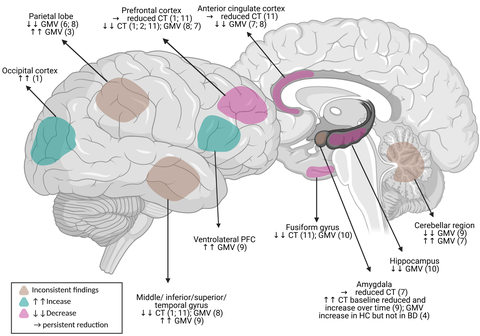Mar 13, 2023
New Article: Longitudinal Neural Changes in Bipolar Disorders

Förster et al (2023)
In a new publication, Katharina Förster, Rosa Horstmann, Udo Dannlowski, Josselin Houenou and Philipp Kanske have jointly gained interesting insights into the relationship between structural changes in the brain and depressive and manic episodes in young and older patients with bipolar disorder:
The first psychopathological symptoms in later bipolar patients often occur in childhood and adolescence, so it is particularly interesting to study bipolar disorder in early stages (adolescence) and the later course of the illness (adulthood). In their systematic literature review, the researchers compared results from eleven longitudinal imaging studies with a total of 329 bipolar patients and 277 healthy control subjects. They were particularly interested in how the grey matter and the volume of the brain change over time in connection with the course of bipolar disorder.
In the entire sample, relapses into manic or depressive episodes were associated with increased loss of grey matter, brain volume and cortical thickness. While adult patients showed an increased decrease in brain structure compared to healthy adult subjects, adolescents with bipolar disorder showed no increase in grey matter, brain volume and cortical thickness compared to healthy adolescents. Of particular interest was that adolescents showed a decrease in amygdala volume shortly after the onset of their illness, a finding that was not reported in adults.
The results suggest that adolescent onset is associated with specific brain structural changes. These brain structural changes could result from an interplay between brain maturation processes and the onset of bipolar disorder. The results also indicate that even these first episodes in adolescence are associated with structural changes in the brain.
Therefore, in clinical practice, adolescents and young adults who show evidence of developing bipolar disorder should be monitored over time and receive early individually planned treatment in favor of a 'wait and see' approach.
You can read the article here.
